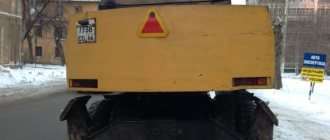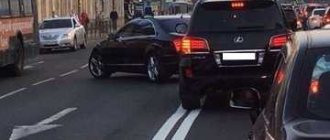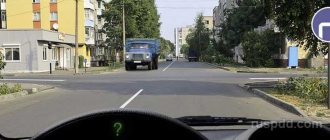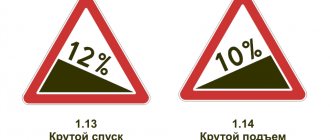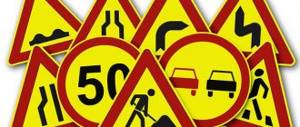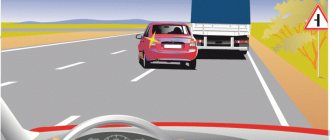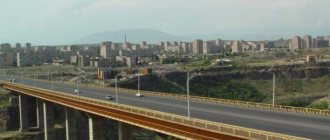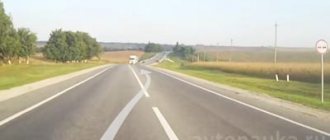In slow city traffic, any unexpected stop causes a lot of emotions. A bus stopped at a stop slows down the flow. Cars have to slow down and wait, but some impatient drivers suddenly take off and drive around the bus in the oncoming lane through a solid marking line, forcing oncoming traffic to hug the side of the road. Others nervously honk in the traffic, demanding that cautious drivers repeat a similar maneuver.
If such impatient people are stopped by the traffic police, they justify themselves by saying that they considered the bus to be an insurmountable obstacle that can be driven around in oncoming traffic. How right are they?
Article on the topic...Do I need to retake the exam at the traffic police after deprivation of my license for driving into oncoming traffic?
What does solid mean?
Today, various marking schemes are used on public roads.
They simultaneously perform several different functions:
- mark acceptable trajectories for drivers;
- indicate the possibility of performing certain maneuvers;
- other.
It is very important for every driver to know what exactly this or that marking means. And also the color.
Since depending on it, the designation of this type of traffic order will differ. For example, if the markings are yellow, this has a special meaning.
You need to be especially careful with continuous markings. Since violation of the traffic regime through it in some cases implies not just a fine, but also deprivation of a driver’s license.
For example, such a maneuver as turning or turning across a solid marking line will imply the deprivation of a driver's license. A solid marking line is designated as 1.1.
It is important and is interpreted taking into account two points at once:
- road markings of this type are usually used in the “inner” part of the road surface, and not along the edge;
- Marking 1.1 is strictly not allowed to be crossed from any side - and in any case, not only when turning or overtaking.
It is on the basis of the points outlined above that it is necessary to “use” such markings. Moreover, it is worth noting that there are a number of combination options for continuous markings.
The most common options:
- solid single type – used on roads with two or three lanes – indicates a prohibition on entering the oncoming lane, regardless of various circumstances;
- if the markings on sharp turns become intermittent after which it becomes solid again - this does not mean a change in its meaning; the ban on entering the oncoming lane will still apply.
For violation of the rules regarding maneuvers through markings, in some cases a fine or imprisonment is implied.
Moreover, the assignment of any specific punishment directly depends on the exact circumstances in which a particular violation takes place.
Moreover, it is important to distinguish between the following two concepts, which are often deliberately confused by traffic police officers when classifying a violation:
- avoiding obstacles on the road, getting ahead;
- overtaking.
Definitions
Stopping a vehicle is an intentional cessation of movement for a period of up to five minutes. If we talk about vehicles carrying passengers, then the concept of a stop can also include a time exceeding the specified period, but only if this is necessary for boarding and disembarking people.
Parking is a complete cessation of movement by the driver for a period of five minutes. When parked, the engine usually turns off, and the driver can leave the vehicle and go about his business.
An obstacle is a defect on the road, i.e. repair work, an accident of other cars, or simply a stopped broken vehicle can be an obstacle.
Detour is a maneuver aimed at avoiding obstacles on the road. A detour can be made either within your own lane or by entering the oncoming lane. It must be remembered that driving through a continuous lane between streams of cars traveling in the opposite direction is punishable by fines.
Overtaking or bypassing a bus standing at a stop
It is necessary to understand the term “overtaking” in advance. The legislation and traffic rules provide a fairly clear and precise definition of what constitutes overtaking.
This maneuver involves entering the oncoming lane of traffic by changing lanes and returning to it. Advancing is moving at a speed exceeding the speed of the vehicle driving next to you.
It is equally important to understand the meaning of the term “obstacle avoidance”. This refers to a maneuver involving leaving the occupied lane into the oncoming lane and then changing lanes. In this case, there must be an obstacle.
Often there is no pocket at the bus stop. For this reason, it is necessary to detour around it. And in the absence of a broken marking line, this will be a serious violation.
It is worth remembering that driving in violation does not imply deprivation of your driver's license. At the same time, overtaking through a solid line means 100% deprivation of your driver's license.
That is why traffic police officers usually try to create a detour for overtaking. Moreover, they do this deliberately, often with the aim of extorting money.
Therefore, it is important to familiarize yourself with the regulatory documentation, traffic rules and the Code of Administrative Offenses of the Russian Federation in advance. This will allow you to independently protect your own rights. Prevent a variety of other problems.
How much it costs to buy an overtaking mirror for right-hand drive cars is shown in the article: overtaking mirror for right-hand drive cars. Is it prohibited to overtake on a hill? Read here.
basic information
The standards outlined in the traffic rules are not clear from the first reading. Some situations require a comparison of phrases from traffic rules contained in different sections.
The question of whether it is possible to bypass a bus stopped at a bus stop is covered by different articles of traffic rules, which must be compared and understood as you study.
So, it will be important to find out in solving the situation:
- What is a stop and what is a vehicle parking.
- What can be considered an obstacle on the road.
- In what cases is it possible to detour into oncoming traffic?
- What sanctions are provided for incorrectly performing a detour or overtaking a bus at a bus stop across a continuous road?
What is the right thing to do in this situation if there is no pocket for stopping?
Situations where road infrastructure is not properly thought out arise quite often. And often the bus becomes an obstacle when it boards passengers.
If there is a broken marking line, this will not be a big problem - it will be enough to just go around.
The presence of a broken line in the absence of prohibitory signs implies the possibility of overtaking. In the absence of oncoming traffic.
But if there is a continuous marking line and the bus is blocking the passage, then the optimal solution would be to simply wait for it to pass.
Because otherwise it is possible:
- imposition of a serious fine on the driver;
- confiscation of a driver's license through the court.
Before performing any maneuver, it is important to pay attention to the signs and markings. Violation of the rules is not permitted under any circumstances. But it often happens that the driver still crosses the solid road when the bus stops on the roadway.
If the traffic police officers recorded this moment, then there is no point in conflict. It is necessary to sign the protocol, but it is important to pay attention to the classification of the violation.
It is important to remember that driving around an obstacle not according to the rules only implies a fine of a certain amount. This point is regulated by Art. No. 12.15.3 Code of Administrative Offenses of the Russian Federation.
In turn, overtaking through a continuous road is classified as a more serious violation.
And it implies the following administrative penalties:
- a fine of a certain amount;
- revocation of a driver's license.
This moment is regulated by the following articles of the Code of Administrative Offenses of the Russian Federation:
- 12.15.4 – overtaking through a continuous road;
- 12.15.5 – overtaking through continuous markings again.
If traffic police officers classify an obvious detour through a solid obstacle as overtaking, you must sign the protocol and also make the appropriate inscription “I do not agree with the data.”
Only in this case will it be possible to successfully challenge this kind of decision of the traffic police.
It is equally important to understand what is meant by the term “obstacle.” It is an immovable object in the traffic lane where the driver’s car is located.
An obstacle may mean:
- immovable object – a faulty, damaged vehicle;
- foreign objects or something else similar.
The reason for imposing a fine is that a bus located at a stop for loading and unloading passengers is not classified as an obstacle.
It is on this basis that many traffic police officers classify this situation as overtaking.
It is important to note that the definition of “obstacle” does not include a traffic jam or a car stopped in the traffic lane in accordance with the rules of the road.
If the bus driver turns on the hazard warning lights, again, not everything will be clear.
Another ambiguous situation is overtaking a bus at a stop through a continuous road with one wheel. Today, in such a situation, one should be guided by clause 9.7 of the Traffic Regulations, clause 1.1.
Appendix No. 2 to these Traffic Rules. Today it is prohibited to drive beyond such markings into the oncoming lane.
It is important to note that the markings themselves are not classified as road surfaces. That is why it is possible to hit one.
At the same time, if even one wheel touches the oncoming lane through a solid line, such an action already falls under the relevant sections of the Code of Administrative Offenses of the Russian Federation. Therefore, such situations should not be allowed.
In order to deal with this situation as accurately as possible and avoid any troubles, it is necessary to avoid such violations.
Today, judicial practice shows that a violation involving driving one wheel into oncoming traffic in 100% of cases means deprivation of a driver’s license.
If the recording was carried out directly by a traffic police officer. It is important to familiarize yourself with all traffic rules in advance and avoid situations that can be interpreted in two ways.
This will save time and money, as well as protect your own driving license.
As stated in the traffic rules
The traffic rules indicate the following points:
- It is prohibited to overtake or bypass a bus through a continuous marking line - when it is located for disembarking passengers on the traffic lane;
- It is not allowed to drive even one wheel onto the road surface beyond the marking line.
You should be especially careful with the intersection of a solid line. Since recording can be carried out not only by traffic police officers, but also by video cameras and other devices.
Punishment for breaking the rules
The penalties for this type of violation are as follows:
| When such overtaking is detected by automated systems | a fine of 5 thousand rubles (notification receipt will be sent by mail) |
| When a violation is recorded directly by traffic police officers | your driver's license will be revoked for a period of 4 to 6 months |
In case of repeated violation of this kind, deprivation will take place for 12 months. Today, overtaking through a continuous road promises serious problems for the driver.
Therefore, it is necessary to carefully study the traffic rules and not violate them - in order to avoid a serious fine, as well as deprivation of a driver’s license.
How double overtaking is prescribed in the traffic rules is explained in the article: double overtaking. Where the overtaking prohibited sign ends, see the page.
TEXTLearn from this information.
Who is right and who is wrong?
According to traffic rules, crossing a double continuous line is punishable by a fine or deprivation of a driver's license. There are no exceptions in which a driver can cross these lanes with impunity. That is, if, when overtaking, a motorist crosses a double solid line, he will be held accountable.
The main point that drivers do not agree with is the correct classification of this offense. In accordance with the provisions of Article 12.15 of the Code of Administrative Offences, such a departure can be interpreted in two parts at once:
- Part 3 contains a requirement to hold a driver accountable for entering a lane intended for oncoming traffic and applies to cases where a motorist avoids obstacles. For such an offense, the driver is held accountable in the form of a fine in the amount of 1 to one and a half thousand rubles.
- Part 4 of the same article of the traffic rules provides for liability for entering the lane intended for oncoming traffic or onto tram tracks in cases not provided for in part one. For such a violation, the driver will have to pay a fine of 5 thousand rubles or lose his license for up to 6 months.
It would seem that the difference lies only in the presence or absence of an obstacle, but the amount of responsibility is strikingly different. In addition, in a situation where the driver is charged under Part 4 again, the period of deprivation of rights is already 1 year.

